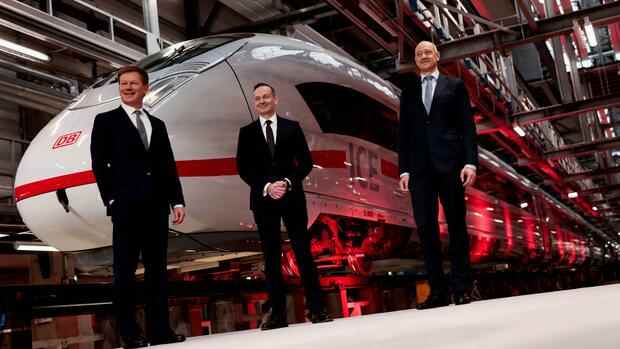“I am particularly pleased that Deutsche Bahn has given us a follow-up order,” said Roland Busch, CEO of Siemens AG. The train was developed in record time. “By the end of this year we will be putting the first trains on the rails.” In total, Deutsche Bahn will be getting 73 ICE 3 neo. The high-speed train is a further development of the ICE 3, which has been in operation since 1997. There is a reason why Deutsche Bahn decided to order the older and not the new ICE 4: The ICE 4 is only approved for just under 250 kilometers per hour.
If the train is to run significantly faster, the Federal Railway Authority demands higher standards, for example in terms of stability or braking. The ICE 3, with its 10,900 horsepower, is already certified for 320 kilometers per hour, even if it has so far only traveled at this speed in France because the German rail network does not provide such a high speed.
In order to get new trains quickly, the railway management decided to have the ICE 3 modernized. The first trains are to be deployed at the end of the year, initially on routes between North Rhine-Westphalia and Munich. “The train was completed in the record time of just twelve months, faster than any other ICE before,” said Bahn boss Lutz.
Top jobs of the day
Find the best jobs now and
be notified by email.
Grid film is designed to let radio waves in
The ICE 3 neo has hardly changed on the outside, but a lot has happened on the inside. Probably the most important innovation for many travellers: mobile phone reception should be significantly better than before. “If we look at what we get in the Ministry for letters, then that’s one of the most urgent problems at the moment,” said Federal Transport Minister Volker Wissing (FDP) on Tuesday at the presentation of the ICE 3 neo.
Better reception is made possible by other windows. So far, these have had a thin metal layer as thermal insulation. This acts like a Faraday cage, mobile phone waves do not reach the interior of the car. In the future, a grid will be burned into this film by a laser, which will allow the radio waves to pass through.
Anyone who works regularly on the train can also firmly mount their tablet on the backrest of the front seat in the new model. There are larger compartments for families. And if you want to take your bike with you on the train journey, you can do so in the new ICE without any problems. Each train has eight parking spaces. “The trains offer the necessary attractiveness to motivate more people to use the rails,” says Federal Transport Minister Wissing with conviction. “We want to double the number of passengers in the next eight years.”
But even if there is a lot in the new ICE, it can only develop its full performance if the German rail network allows it. This is probably the biggest weakness in Deutsche Bahn’s ambitious growth plan. The minister knows that too. “There are structural tasks to solve, such as the German rail network, which has been overloaded for years,” says Wissing.
For the time being, the new high-speed trains will probably be slowed down again and again, for example by the numerous construction sites. “I am aware that some of you are not satisfied with the operational quality of the network. And I want to say it quite frankly: I’m not either,” Ronald Pofalla, Deutsche Bahn’s infrastructure director, admitted last week at a group event.
Above all, the construction site management, i.e. the coordination between the construction measures and the ongoing traffic, was criticized last year. Pofalla promises that this will not happen again. “We want to improve the construction measures here so that there are fewer disruptions.”
But rail customers should not hope that the construction sites will be faster in the future. When Deutsche Bahn promises better construction site management, this primarily means that the delays caused by the construction work are better taken into account in the timetable. The customer then drives longer, but at least he knows when he will arrive.
>> Read about this: Train and plane: irritable atmosphere on board: “Some are nervous”
Nothing is going to change anytime soon. “We will invest a total of 170 billion euros by 2030,” said Pofalla. Above all, the so-called main corridors are overutilized. According to Pofalla, they only make up about ten percent of the entire rail network. But delays that occur here build up throughout the day throughout the rail network.
Nevertheless, Minister of Transport Wissing is confident that the new ICE 3 neo will bring improvements: “The trains are significantly faster, which also increases capacity on the network.”
More: Flixtrain plans to invest billions in new trains
